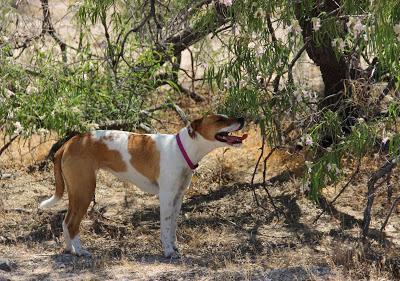
After a short drive on a rough 2-track through creosote scrub, I parked at a dry sandy wash below the object of my desire—a young lava flow, maybe just 10,000 years old. But as soon as I got out of the car, all thoughts of geology fled. They were driven off by a huge tree, flamboyant with flowers.
 Huge and flamboyant by desert standards for sure!
Huge and flamboyant by desert standards for sure!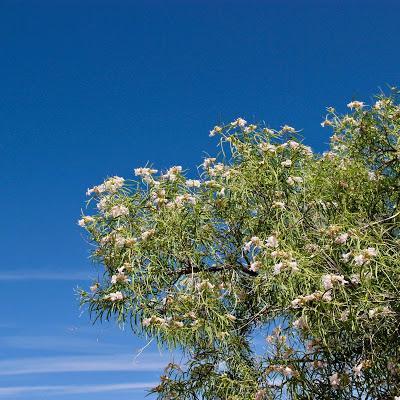 Based on the impressive green (not gray-green) canopy and large trumpet-shaped flowers, I concluded the tree was an escapee, an ornamental that somehow managed to get established in the wash. Such verdure and floral showiness are out of place in the desert. Later I stopped at Kelso, the old railroad depot in the middle of the Mojave, where helper engines were stationed to help trains up the steep Cima grade (more here). I immediately noticed the same trees lining the parking lot. Yes! definitely an escaped ornamental. But then a vague memory began to take shape.
Based on the impressive green (not gray-green) canopy and large trumpet-shaped flowers, I concluded the tree was an escapee, an ornamental that somehow managed to get established in the wash. Such verdure and floral showiness are out of place in the desert. Later I stopped at Kelso, the old railroad depot in the middle of the Mojave, where helper engines were stationed to help trains up the steep Cima grade (more here). I immediately noticed the same trees lining the parking lot. Yes! definitely an escaped ornamental. But then a vague memory began to take shape. The depot now houses the Visitor Center for Mojave National Preserve. In the bookstore, I read about trees in desert washes. Then it all came came back: Chilopsis linearis, the desert willow, was one of the key species of desert washes that we committed to memory forty years ago. If we saw it on our field trip to the Mojave, that memory is long gone. But I’m sure we did not see it in flower … at least not flowering in such profusion. That I would have remembered.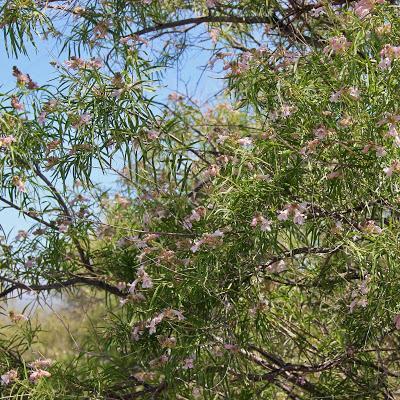
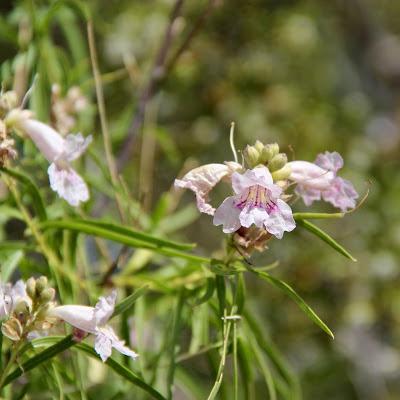 The desert willow is unusual in other ways. Not really "unusual" of course, but rather surprising … as I knew so little about its life. Since that day we met beside the lava flow, I’ve learned a lot.First, desert willow is not a willow, not even close. If it were, it would be in the genus Salix in the Salicaceae (willow family). Instead, the genus is Chilopsis in the Bignoniaceae (catalpa family, mainly tropical). The common name is understandable. Desert willow is associated with stream channels (though usually dry), and the leaves look superficially like those of several familiar willows (e.g., Salix exigua, narrowleaf willow).
The desert willow is unusual in other ways. Not really "unusual" of course, but rather surprising … as I knew so little about its life. Since that day we met beside the lava flow, I’ve learned a lot.First, desert willow is not a willow, not even close. If it were, it would be in the genus Salix in the Salicaceae (willow family). Instead, the genus is Chilopsis in the Bignoniaceae (catalpa family, mainly tropical). The common name is understandable. Desert willow is associated with stream channels (though usually dry), and the leaves look superficially like those of several familiar willows (e.g., Salix exigua, narrowleaf willow).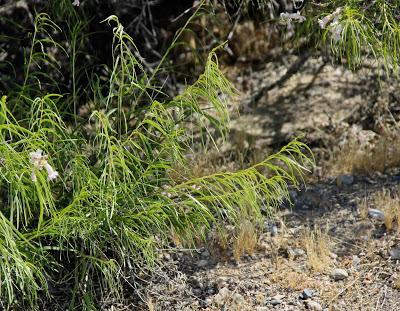 Chilopsis linearis is the only species in the genus, and is the only native member of the catalpa family in California (source). It’s native to south-central Texas, south to Nuevo Leon and Zacatecas, and west to southern California and Baja California.At first glance, desert washes look just as dry as the surrounding uplands. But they’re not. After the occasional heavy rain, torrents of water rush down the wash, and quite a bit gets stored underground. This explains the heavier growth of wash-specific shrubs and trees on the banks. But desert willow often grows in the middle of washes, where it must bear the full brunt of flash floods. It can do this because it’s so well-anchored with its strong deep root system. And even in the searing heat of a Mojave summer, its roots provide enough groundwater to support a full compliment of leaves until the first hard frost.
Chilopsis linearis is the only species in the genus, and is the only native member of the catalpa family in California (source). It’s native to south-central Texas, south to Nuevo Leon and Zacatecas, and west to southern California and Baja California.At first glance, desert washes look just as dry as the surrounding uplands. But they’re not. After the occasional heavy rain, torrents of water rush down the wash, and quite a bit gets stored underground. This explains the heavier growth of wash-specific shrubs and trees on the banks. But desert willow often grows in the middle of washes, where it must bear the full brunt of flash floods. It can do this because it’s so well-anchored with its strong deep root system. And even in the searing heat of a Mojave summer, its roots provide enough groundwater to support a full compliment of leaves until the first hard frost.
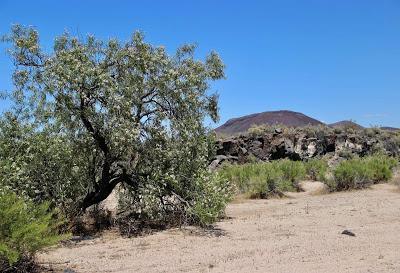
Desert willow in mid-wash, with young lava flow and somewhat older cinder cone behind.
Desert willow is tough in other ways. Atchley and colleagues (1999) noted that water transport in trees and gas exchange in leaves (e.g., uptake of carbon dioxide for photosynthesis) change very little during times of low water availability:“Desert willow can maintain near normal water potentials and gas-exchange rates during periods of low water availability (Odening et al., 1974; de Sozya et al., in review). This obligate riparian species appears to be highly adapted to minimizing its physiological responses to the often extreme environmental changes common to arroyo habitats.” (italics added)Flowers typically are most abundant in May and June, with stragglers hanging on through the summer. If there’s enough late summer rain, another burst of flowers may follow. The seed pods are conspicuous, being up to ten inches long (35 cm). They stay on the tree, and split to produce abundant tiny winged seeds.
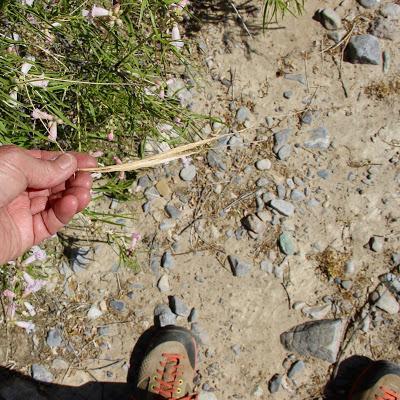
Seed pod from last year, still on tree.
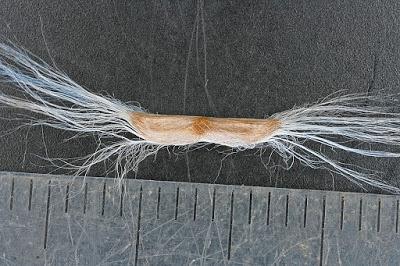
Desert willow seeds (source); photo by Russ Kleinman. Scale is metric.
Turns out my first impression wasn’t totally wrong. Desert willow is used as an ornamental. In fact, many cultivars have been developed. It’s also popular for soil stabilization projects in the America Southwest.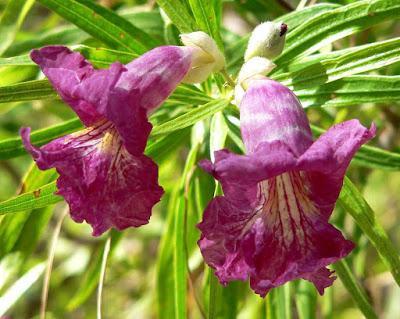
Cultivar 'Rio Salado' at the Springs Preserve garden in Las Vegas (courtesy Stan Shebs).
This is my contribution to June’s tree-following gathering, kindly hosted by The Squirrelbasket. Obviously I’m not following a given tree. I have just about given up on the one I chose for 2017: Sabalites powellii, an extinct palm. If things had gone as planned, I would be visiting its ancient habitat today!! And you would read about it next month. But the Fickle Finger of Fate intervened, specifically the Wyoming weather. After finishing field work, I drove to the nearest town and checked the 3-day forecast for Fossil Butte National Monument: heavy rain, rain and snow with a low of 34º F (1º C), then more heavy rain. So I drove home. Maybe in September … Sources (in addition to links in post)Atchley, MC, et al. 1999. Arroyo water storage and soil nutrients and their effects on gas-exchange of shrub species in the northern Chihuahuan Desert. J. Arid Environments 43: 21–33. PDF
Sources (in addition to links in post)Atchley, MC, et al. 1999. Arroyo water storage and soil nutrients and their effects on gas-exchange of shrub species in the northern Chihuahuan Desert. J. Arid Environments 43: 21–33. PDFUSDA Forest Service. Fire Effects Information System (FEIS). Chilopsis linearis. https://www.fs.fed.us/database/feis/plants/shrub/chilin/all.html (accd 12 June 2017).If you aren’t familiar with the FEIS database, you should be! It contains thorough compilations of plant information (though not for gardening). You’re a lucky person if your species of interest is included.
